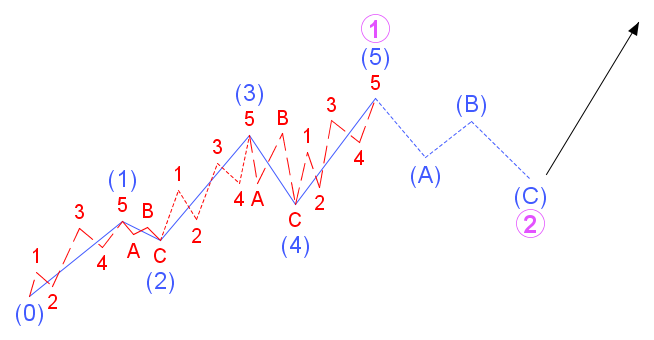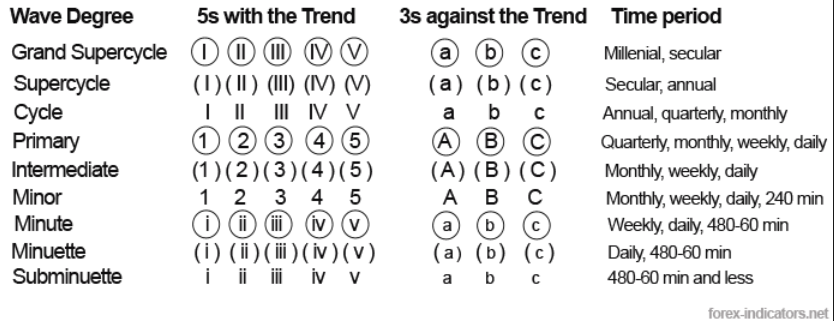Elliott Wave Cheat Sheets
Other Helpful Sources
Rules and Guidelines Applicable to All Motive and Corrective Waves
The rules and guidelines governing specific waves are described below, and along with the specific waves to which they apply. You should note that rules are, in fact, requirements. If you find a rule has been violated, even by a little, you should proceed to an alternate wave count. On the other hand, Guidelines don't have to be true, but they are so frequently true (somewhere along the order of 80 to 90% of the time) that they can be assumed to be true and relied upon. 80% reliability is a huge statistical advantage in the stock market. It is these guidelines that provide the real predictive power behind the Elliott Wave theory.
We break down the guidelines applicable to Elliott Wave Theory into two categories, major and observational. The observational guidelines are covered in the sections for each of the particular waves and wave structures.
Motive Waves -- Impulse Waves and Diagonals
Impulse Waves
RULES:
- Wave 2 may never move beyond the origin of wave 1 (retrace more than 100% of wave 1).
- Wave 4 may never enter the price territory of wave 1.
- Wave 3 may never be the shortest wave.
- Impulse waves always subdivide into 5 waves.
- Waves 1, 3, and 5 are always 5 waves.
GUIDELINES
- Wave 3 always exceeds the pivot of wave 1
- On rare occasion, wave 5 will not move beyond the pivot of wave 3. This is known as Truncation
- Normally, wave 3 will extend. Occasionally two waves will extend. Never will all three extend.
- When wave 3 extends, wave 5 tends to equal wave 1 in length.
- When wave 5 extends it frequently reaches to the length of waves 1 plus 3.
- Wave 1 is the least likely to extend.
- Often the extended wave corresponds with the current parent wave. (eg. In a higher degree wave 5, it is common for the lower degree wave 5 to extend)
- Often the extended wave will match the number of the current parent wave
- The center of Wave 3, normally has the steepest slope of the entire 5 wave structure, except perhaps the "kickoff" of wave 1.
- Wave 2 will develop into a zigzag, flat, or combination. Wave 2 cannot be a triangle in its entirety.
- Wave 4 will develop into a zigzag, flat, combination, or Triangle.
- Wave 5 frequently ends near channel marked by line from 2-4 pivots, extended to wave 3 pivot.
Leading Diagonals - 5 waves (3-3-3-3-3)
RULES
- Will always subdivide into 5 waves.
- Wave 2 never goes beyond the origin of Wave 1.
- Wave 3 always goes beyond the wave 1 pivot.
- Wave 4 always enters the price territory of Wave 1 but never ends beyond the pivot of Wave 2.
- Wave 5 will always end beyond the Wave 3 pivot - No truncation unless a contracting diagonal.
- Waves 2 and 4 will always be a zigzag. Waves 1, 3. and 5 can be zigzags, but may appear as 5 wave structures.
- A Leading Diagonal can only appear as wave 1 of an impulse or wave a of a zigzag - the first wave of a sequence.
- Leading Diagonal - Waves 2 and 4 of a leading diagonal, always subdivide into zigzags. Waves 1,3, and 5 may or may not.
GUIDELINES
- If Wave 1 is a leading diagonal, wave 3 is almost surely going to extend.
Ending Diagonals - 5 waves (3-3-3-3-3)
RULES:
- Will always subdivide into 5 waves.
- Wave 2 never goes beyond the origin of Wave 1.
- Wave 3 always goes beyond the wave 1 pivot.
- Wave 4 always enters the price territory of Wave 1 but never ends beyond the pivot of Wave 2.
- Wave 5 will always end beyond the Wave 3 pivot - No truncation unless a contracting diagonal
- Can only appear as wave 5 or wave c. - the final wave of a sequence
- All 5 waves will always subdivide into zigzags.
GUIDELINES
- If Wave 3 had not extended, Wave 5 almost surely not be an ending diagonal.
- Most diagonals converge (trend lines 1_3 and 2_4)
Corrective Waves - Zigzags, Flats, Triangles, and Combinations
Zigzags - 3 waves (A5-B3-C5)
RULES:
- A zigzag always subdivides into 3 waves
- Wave A of a zigzag is 5 waves, it is either an impulse or (rarely) a leading diagonaal
- Wave B of a zigzag never moves beyond the origin of Wave A.
- Wave B of a zigzag always subdivides into a zigzag, flat, triangle, or combination of the three.
- Wave C of a zigzag always subdivides into an impulse or (rarely) an ending diagonal.
GUIDELINES
- Wave B in a zigzag will normally retrace 50 to 79 percent of wave A.
- Wave C of a zigzag almost always ends beyond the pivot of wave A, but it can truncate.
- Wave C of a zigzag is frequently equal in price distance with wave A.
- Wave C often ends at a trend line drawn from the wave A origin to wave B and duplicated to the wave A pivot. As with all corrections, they are normally contained within these channel parallel lines.
Flats - 3 waves (A3-B3-C5)
RULES:
- A flat always subdivides into 3 waves.
- Wave A of a Flat is usually a zigzag.
- Wave B of a Flat is usually a zigzag, but can be a triangle or combination.
- Wave B of a flat must retrace at least 90 percent of wave A, or it is not a flat. It may retrace up to 105% and still be considered a flat. Thereafter, it is considered an Explanded Flat.
GUIDELINES
- In an Expanded Flat, Wave B and normally between 105 and 138 percent of wave A. Beyond that, it is less likelly to be a Flat at all.
- Wave C of a Flat normally ends beyond the pivot of wave A, even in an Expanded Flat.
- Wave C of an Explanded Flat normally ends beyond the pivot of wave A as well, but if it fails to do so it is called a "Running Flat."
Triangles - 5 waves (A3-B3-C3-D3-E3)
RULES:
- A triangle is always subdivided into 5 waves, labeled A-E.
- At least 4 waves of a triangle are 3 wave zigzags or a zigzag combination (a double or triple zigzag).
- Wave C of a triangle NEVER moves beyond the pivot of wave A. Wave D NEVER moves beyond the pivot of wave B. Wave E NEVER moves beyond the pivot of wave C.
- A triangle never has more than one complex subwave. If it does, it is always a zigzag combination or a triangle.
GUIDELINES
- Wave B may exceed the origin of wave A, creating a "running triangle." This happens about 40% of the time.
- Waves B and D may at times pivot at about the same level. When this happens if forms a "barrier triangle."
- If a zigzag combination is going to form, it is usually it is wave C. It is longer lasting and contains deeper percent retracements than the other waves. Wave D is the 2nd most likely. The wave X of a zigzag combination can be a triangle as well.
- Wave C, D, or E can develop into an internal triangle. If this happens, it almost always is wave E.
- Most triangles are of the contracting variety, where each sucessive wave retraces about .618 of the previous wave.
- With expanding triangles, each wave expands the previous wave by approximately 105 to 125%
Combinations
Combinations are a series of two or possible 3 corrective structures that are separated by an X wave. When the corrective structures are all zigzags, they are known as a double zigzag or a triple zigzag. When they are not all zigzags, they are referred to as a double three or a triple three and can be comprised of any corrective structures. A zigzag and a flat, a flat and a flat, a flat and a triangle, etc.
RULES:
- Each of the corrective structures in a combination adhere to the rules of that structure.
GUIDELINES
- X waves most typically are 3 wave zigzags, although can at times take the shape of a 5 wave triangle.
Count the Waves
Counting all up and down pivots you have:
- 3 waves - Check for an ABC structure or a leg of a triangle or diagonal.
- 5 waves - Check for an impulse structure
- 7 waves - Check for a WXY structure.
- 9 waves - Check for an extended impulse
- 11 waves - Check for a WXYXZ structure
- 13 waves - Check for a double extended impulse wave (3 1-2's)
Wave Structure
A single "Wave" is composed of an 8 wave structure, which in turn is comprised of similar 8 wave structures. In the diagram below, note the 8 waves (1-5 and A,B.C) marked in gray. Inside of those 8 waves are similar 8 wave structures marked

Determine the Elliott Wave Degree
What degree you are labeling your wave structure is not terribly important unless you are a long term forcaster, but you need to be consistent in your labelling. if you also review and rely on the charts of others, such as The Elliott Wave Lives On site, or Elliott Wave international, it is very helpful to use wave degrees consistent with theirs.
We use the following method to identify degree. If the waves you are looking at are generally visible (you can see a few of the swings, but not identify the internal waves) on the first time chart listed, and clearly visible (you can identify most of the internal waves) on the second time frame, we use the following wave degree:
| Generally Visible Waves | Clearly Visible Waves | Probable Wave Degrees (smallest to largest) |
| Weekly | 2 Day | Minor, Intermediate, Primary or above |
| 2 Day | 3-4 Hour | Minuette, Minute, Minor, Intermediate |
| Daily | 1 Hour | Subminuette, Minute, Minor, Intermediate |
| 1 Hour | 15 Minute | Subminuette, Minute, Minor |
| 30 Minute | 10 Minute | Micro, Subminuette, Minute, Minor |
| 15 Minute | 5 Minute | Submicro, Micro, Subminuette, Minute |
| 5 Minute | 2 Minute | Miniscule, Submicro, Micro, Subminutte |
So as a general rule, we will look at a chart structure from a significant low or high on a daily chart that encompasses all of the available data. If you are using a monthly chart, start labeling the waves in the Cycle degree, If a weekly chart, start with the Primary degree, and daily as the Minor or Intermediate degree.

Tradable Wave Degrees
All waves can be traded, especially on the impulse structure, but when you reach the Subminuette Degree and lower the ability to profitably trade the corrective waves becomes challenging to all but the most experienced traders. The difficulty in accurately labeling the swing in real time coupled with the cost of commissions, the difficulty in accurately predicting the wave terminus and the inherent potential of a wrong wave count, make trading the smaller degrees something that should be left to the experts. If you are interested in trading once or twice a day, you can trade the subminuette waves and ride out the smaller waves.
